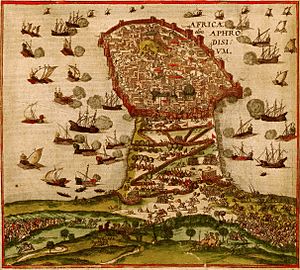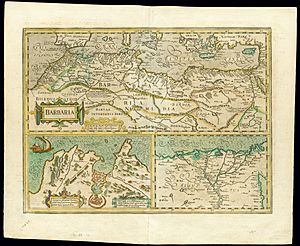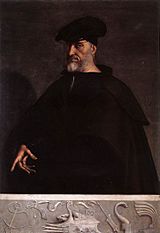Capture of Mahdia (1550) facts for kids
Quick facts for kids Capture of Mahdiye |
|||||||
|---|---|---|---|---|---|---|---|
| Part of Ottoman-Habsburg wars | |||||||
 Mahdia in 1535. Engraving of 1575 by Braun and Hogenberg. |
|||||||
|
|||||||
| Belligerents | |||||||
| Commanders and leaders | |||||||
| Andrea Doria Bernardino de Mendoza Claude de la Sengle |
Turgut Reis Hesar |
||||||
| Strength | |||||||
| 52 galleys 28 naos Unknown soldiers |
Unknown in Mahdia 3,700 Moors 800 Turks 60 cavalry |
||||||
| Casualties and losses | |||||||
| 500 killed and 1,000 wounded | 7,000 killed or captured in the assault | ||||||
The capture of Mahdia was an important military event. It happened between June and September 1550. This operation involved both land and sea forces (an amphibious operation). It was part of a bigger fight between the Ottoman Empire and the Spanish Empire. Both empires wanted to control the Mediterranean Sea.
A Spanish fleet, led by Admiral Andrea Doria and Bernardino de Mendoza, attacked the city. They were helped by the Knights of Malta. Mahdia was an Ottoman stronghold. It was defended by the famous Ottoman Admiral Turgut Reis, also known as Dragut. He used Mahdia as a base for his pirate attacks on Spanish and Italian coasts.
The Spanish forces successfully captured Mahdia. However, Spain left the city three years later. All its defenses were destroyed. This was done to stop the Ottomans from using it again.
Contents
Why Mahdia Was Important

In 1550, the Hafsid kingdom of Tunis was in chaos. This kingdom covered parts of modern Algeria and Libya. Many local leaders fought each other. They did not obey the Sultan of Tunis, Abu al-Abbas Ahmad III.
The Ottoman admiral Turgut Reis, or Dragut, saw his chance. With help from a local leader, he took control of Mahdia. This coastal town was built on a rock by the sea. It had strong walls, towers, and a moat.
Turgut Reis had already attacked the coasts of Italy in 1546. He captured Mahdia as part of this campaign. European leaders worried that Mahdia would become a major base for pirates. These pirates, called Barbary corsairs, attacked Christian ships in the Western Mediterranean.
So, Emperor Charles V decided to act. He was supported by the Papacy (the Pope) and the Knights of Malta. They planned a large expedition to capture Mahdia.
The command of this mission went to Andrea Doria, a Genoese admiral. Bernardino de Mendoza was also a key Spanish commander. Their fleet included 52 large warships called galleys and 28 large cargo ships called naos. They carried many soldiers, siege weapons, and supplies.
The Expedition to Mahdia
Starting the Siege
The Spanish fleet sailed towards Mahdia on June 24. They arrived four days later. The city was defended by Hesar, Turgut Reis's nephew. Hesar had prepared for a long siege. He had stored enough food for a year.
Spanish troops landed safely. They were protected by cannons from their ships. Within hours, they pushed back the Ottoman soldiers from a nearby hill. The next day, the city was completely surrounded. Soldiers dug trenches about 600 meters from the walls.
Luis Pérez de Vargas led the Spanish artillery. He set up heavy cannons on the hill. Lighter cannons were moved closer to the walls. The first attack on the city failed. The moat around the city had not been filled yet. Even with better trenches, the attackers struggled. Ottoman soldiers often attacked them from the city.
Ottoman Help Arrives
Turgut Reis heard about the siege while raiding the coast of Valencia. After being pushed back from some Spanish towns, he sailed along the Barbary Coast. He asked for help and money to raise an army.
The Bey of Tunis and a chieftain from Caruan refused to help him. But Turgut Reis managed to gather some forces. He had 3,700 Moors, 800 Turks, and 60 cavalry soldiers. His fleet secretly landed these troops near Mahdia at night. He also sent a swimmer to tell his nephew Hesar inside the city.
On July 25, Turgut Reis's troops attacked the Spanish. They were hidden in an olive grove. Mahdia's defenders also attacked from the city. They managed to get into the Spanish trenches and camp. But the Spanish fought back hard. Their ships' cannons also helped. The attackers were forced back into Mahdia. Turgut Reis escaped to his ships and left for Djerba. The Spanish won this battle, but they lost many soldiers. Luis Pérez de Vargas, the artillery commander, was among the dead.
Ending the Siege
After this failed attack, Christian commanders sent ships to patrol at night. They wanted to prevent more surprise attacks. Other ships went to Sicily. They carried wounded and sick soldiers. They also asked for more soldiers and ammunition. Supplies arrived from cities like Milan and Genoa.
Engineers looked for weak spots in Mahdia's defenses. García Álvarez de Toledo, 4th Marquis of Villafranca had a clever idea. He suggested bombing the walls from the sea. He used two galleys, stripped of their masts and joined together. Nine cannons were placed on this platform. It was protected by shields. The galleys were then anchored near the walls.
On September 8, the cannons on García Álvarez de Toledo's galleys began firing. Land batteries and other naval cannons also joined in. The bombardment lasted for two days. It created huge holes in Mahdia's walls.
Then, Spanish soldiers stormed the city. They attacked from three different points. One attack was stopped. But the other two broke through the defenses. They surprised the remaining Ottoman troops from behind. The last defenders fought in the towers for a while. But they were finally defeated. Governor Hesar was captured. About 7,000 Mahdia soldiers and civilians were killed or captured.
What Happened Next
Sancho de Leyva stayed in Mahdia with a Spanish army until 1553. Emperor Charles V offered the city to the Knights of Malta. But they did not want it. So, Charles V ordered Mahdia to be destroyed. This was done even though it was an important stronghold. Hernando de Acuña led the demolition work.
Soon after, the Ottomans took Mahdia back. But it was only used for fishing and oil production. The town remained under Turkish rule until the 1800s.
Meanwhile, Sultan Suleiman believed Charles V had broken a peace agreement. He ordered Turgut Reis to continue the war against the Christians. Turgut Reis got more Turkish soldiers. In August 1551, he returned to the Barbary coast. He successfully captured Tripoli from the Knights of Malta.
In 1560, Turgut Reis helped defeat a Christian fleet at the battle of Djerba. But he failed to capture Malta in 1565. This failure, along with another Ottoman defeat, allowed Spain to capture Peñón de Vélez de la Gomera in 1564. The decisive defense of Malta in 1565 was a major Christian victory.
See also
 In Spanish: Toma de Mahdía (1550) para niños
In Spanish: Toma de Mahdía (1550) para niños


